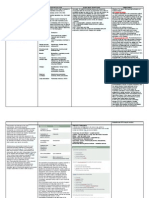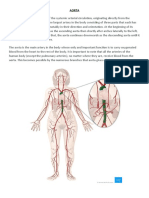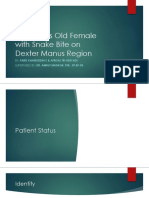Acute Bronchitis
Acute Bronchitis
Uploaded by
Rhea JessicaCopyright:
Available Formats
Acute Bronchitis
Acute Bronchitis
Uploaded by
Rhea JessicaCopyright
Available Formats
Share this document
Did you find this document useful?
Is this content inappropriate?
Copyright:
Available Formats
Acute Bronchitis
Acute Bronchitis
Uploaded by
Rhea JessicaCopyright:
Available Formats
ACUTE BRONCHITIS
Acute bronchitis is inflammation of the upper airways, commonly following a URI. The
cause is usually a viral infection, though it is sometimes a bacterial infection; the
pathogen is rarely identified. The most common symptom is cough, with or without fever,
and possibly sputum production. In patients with COPD, hemoptysis, burning chest pain,
and hypoxemia may also occur. Diagnosis is based on clinical findings. Treatment is
supportive; antibiotics are necessary only for selected patients with chronic lung disease.
Prognosis is excellent in patients without lung disease, but in patients with COPD, acute
respiratory failure may result.
Acute bronchitis is frequently a component of a URI caused by rhinovirus, parainfluenza,
influenza A or B, respiratory syncytial virus, coronavirus, or human metapneumovirus.
Less common causes may be Mycoplasma pneumoniae,Bordetella pertussis,
and Chlamydia pneumoniae. Patients at risk include those who smoke and those with
COPD or other diseases that impair bronchial clearance mechanisms, such as cystic
fibrosis or conditions leading to bronchiectasis.
Symptoms and Signs
Symptoms are a nonproductive or minimally productive cough accompanied or preceded by URI
symptoms. Subjective dyspnea results from chest pain or tightness with breathing, not from
hypoxia, except in patients with underlying lung disease. Signs are often absent but may include
scattered rhonchi and wheezing. Sputum may be clear, purulent, or, occasionally, bloody.
Sputum characteristics do not correspond with a particular etiology (ie, viral vs bacterial). Mild
fever may be present, but high or prolonged fever is unusual and suggests influenza or
pneumonia.
On resolution, cough is the last symptom to subside and often takes several weeks or even
longer to do so.
Diagnosis
Clinical evaluation
Sometimes, chest x-ray
Diagnosis is based on clinical presentation. Chest x-ray is necessary only if findings suggest
pneumonia (eg, abnormal vital signs, crackles, signs of consolidation, hypoxemia). Elderly
patients are the occasional exception. They may require chest x-ray for productive cough and
fever in the absence of auscultatory findings (particularly if there is a history of COPD or another
lung disorder).
Sputum Gram stain and culture usually have no role.
Cough resolves within 2 wk in 75% of patients. Patients with persistent cough should undergo a
chest x-ray. Evaluation for pertussis, with a culture from nasopharyngeal secretions, and
noninfectious etiologies, such as postnasal drip, allergic rhinitis, and cough-variant asthma, may
be needed.
Treatment
Symptomatic relief ( acetaminophen , hydration, possibly antitussives)
Inhaled β-agonist or anticholinergic for wheezing
Sometimes oral antibiotics for patients with COPD
Acute bronchitis in otherwise healthy patients is a major reason that antibiotics are overused.
Nearly all patients require only symptomatic treatment, such asacetaminophen and hydration.
Antitussives should be used only if the cough is interfering with sleep. Patients with wheezing
may benefit from an inhaled β2-agonist (eg, albuterol) or an anticholinergic (eg, ipratropium )
for ≤ 7 days. If cough persists for > 2 wk because of airway irritation, some patients benefit from
a few days of inhaled corticosteroids. Oral antibiotics are typically not used except in patients
with pertussis or in patients with COPD who have at least 2 of the following:
Increased cough
Increased dyspnea
Increase in sputum purulence
Drugs include amoxicillin
500 mg po tid for 7 days, doxycycline
100 mg po bid for 7 days, azithromycin
500 mg po once/day for 4 days, or trimethoprim-sulfamethoxazole
160/800 mg po bid for 7 days.
You might also like
- GORDONS LeukemiaDocument3 pagesGORDONS LeukemiaRhea Jessica50% (2)
- LRN - LEVEL 3 CERTIFICATE IN ESOL INTERNATIONAL CEF C2 - LISTENING WRITING READING AND USE - Sample - Paper PDFDocument16 pagesLRN - LEVEL 3 CERTIFICATE IN ESOL INTERNATIONAL CEF C2 - LISTENING WRITING READING AND USE - Sample - Paper PDFΦΩΤΙΟΣ ΓΟΥΣΙΟΣNo ratings yet
- Bronkitis 2Document12 pagesBronkitis 2Lucky PuspitasariNo ratings yet
- Lower Respiratory Tract Infections (Lrtis) BronchitisDocument11 pagesLower Respiratory Tract Infections (Lrtis) BronchitisAhmed Gh Al-zechrawiNo ratings yet
- Pneumonia Seminar FINALDocument50 pagesPneumonia Seminar FINALdigitalinnovation0519No ratings yet
- Acute Upper Respiratory Infection (AURI)Document58 pagesAcute Upper Respiratory Infection (AURI)api-19916399No ratings yet
- PneumoniaDocument5 pagesPneumoniasamtaynbNo ratings yet
- Acute Bronchiolitis: Zakaria Omar Elzwie Najwa Abdulallah Alfergany (Mub) NovemberDocument28 pagesAcute Bronchiolitis: Zakaria Omar Elzwie Najwa Abdulallah Alfergany (Mub) Novemberزكريا عمر100% (2)
- Acute Bronchitis: HMS Chandra KusumaDocument16 pagesAcute Bronchitis: HMS Chandra KusumaGede Eka Putra NugrahaNo ratings yet
- Acute Bronchitis - Pulmonary Disorders - MSD Manual Professional EditionDocument3 pagesAcute Bronchitis - Pulmonary Disorders - MSD Manual Professional EditionnurulishtimalNo ratings yet
- Bronchitis Acute and ChronicDocument3 pagesBronchitis Acute and Chronicdwi rina putriNo ratings yet
- The Vast Majority of These Illnesses, of Which Is by Far The Most Common, AreDocument17 pagesThe Vast Majority of These Illnesses, of Which Is by Far The Most Common, Aremc22110521No ratings yet
- BrochiectasisDocument31 pagesBrochiectasisabdallah41mfmNo ratings yet
- Bronkitis and PneumoniaDocument16 pagesBronkitis and PneumoniaRegir KurNo ratings yet
- Oxygen Saturation (If Available) : IagnosisDocument3 pagesOxygen Saturation (If Available) : Iagnosisrezairfan221No ratings yet
- Pneumonia in ChildrenDocument22 pagesPneumonia in ChildrenHarsha HinklesNo ratings yet
- Pneumonia: Related Diagnostic TestsDocument2 pagesPneumonia: Related Diagnostic TestsBenj VillanuevaNo ratings yet
- 11-Cough ApproachDocument9 pages11-Cough ApproachAhmed AhmedNo ratings yet
- Pneumonia and Its Type and Detail Note On ManagementDocument5 pagesPneumonia and Its Type and Detail Note On Managementarham.ahmad3112No ratings yet
- 3.pulmonary Alterations - Part 2Document37 pages3.pulmonary Alterations - Part 2Rawan AlotaibiNo ratings yet
- Pneumonia 3Document8 pagesPneumonia 3janinecasilenNo ratings yet
- PneumoniaDocument15 pagesPneumoniaLeina PrasadNo ratings yet
- MCQ Asthma CopdDocument26 pagesMCQ Asthma Copdanisa930804No ratings yet
- Problems in Etiology and Diagnosis of Cough and Chronic CoughDocument38 pagesProblems in Etiology and Diagnosis of Cough and Chronic Coughsszh_No ratings yet
- Establish An AirwayDocument7 pagesEstablish An AirwayMarionne James Jaranilla DinongNo ratings yet
- PneumoniaDocument56 pagesPneumoniamohamednader445No ratings yet
- 4 CapDocument11 pages4 Capshanfiza_92No ratings yet
- 3cough Evaluation and TreatmentDocument3 pages3cough Evaluation and TreatmentdrpmdasNo ratings yet
- Lect 8 Pneumonia PDFDocument68 pagesLect 8 Pneumonia PDFRaghad AbdullaNo ratings yet
- 1.acute Bronchitis 2024 2025Document39 pages1.acute Bronchitis 2024 2025jaouadighitaNo ratings yet
- Revision 2023 Midterm 2Document7 pagesRevision 2023 Midterm 2عبدالرحمنNo ratings yet
- LRTI and PneumoniaDocument6 pagesLRTI and Pneumoniahusenbrz4No ratings yet
- Lung Abscess Bronchoectasis PleurisynDocument19 pagesLung Abscess Bronchoectasis Pleurisynmarco luenaNo ratings yet
- AsthmaDocument31 pagesAsthmakenmanikeseNo ratings yet
- 12lower Respiratory Tract InfectionDocument44 pages12lower Respiratory Tract Infectionmehdikhalid09No ratings yet
- Major Disorders of The Respiratory System: Sheryll Joy Lopez-Calayan, RN, MSNDocument69 pagesMajor Disorders of The Respiratory System: Sheryll Joy Lopez-Calayan, RN, MSNSheryll Joy Lopez CalayanNo ratings yet
- Broncho PneumoniaDocument5 pagesBroncho PneumoniamarkkkkkkkheeessNo ratings yet
- Community Acquired Pneumonia Nelson 400Document37 pagesCommunity Acquired Pneumonia Nelson 400fatima chrystelle nuñalNo ratings yet
- PBL of PneumoniaDocument9 pagesPBL of PneumoniaRobelNo ratings yet
- (Ped-W1) (Dr. Zuhair M. Al Musawi) Repiratory 2Document43 pages(Ped-W1) (Dr. Zuhair M. Al Musawi) Repiratory 2Haider Nadhem AL-rubaiNo ratings yet
- Pneumonia, BronchiolitisDocument65 pagesPneumonia, BronchiolitisYemata HailuNo ratings yet
- PneumoniaDocument48 pagesPneumoniaSiti FatimahNo ratings yet
- PneumoniaDocument20 pagesPneumoniaKartika RezkyNo ratings yet
- Symptoms of Bronchopneumonia in Adults and Children: PneumoniaDocument10 pagesSymptoms of Bronchopneumonia in Adults and Children: PneumoniajessyNo ratings yet
- Pneumonia-Presentation by Raafat Al-AwadhiDocument20 pagesPneumonia-Presentation by Raafat Al-Awadhiرافت العواضيNo ratings yet
- Bronchitis PneumoniaDocument27 pagesBronchitis PneumoniaCininta Anisa Savitri100% (1)
- Respiratorio PerrosDocument4 pagesRespiratorio PerrosErnesto Enriquez PozosNo ratings yet
- Pneumonia 1Document31 pagesPneumonia 1Parushhni NandhagopalNo ratings yet
- Pneumonia 1Document17 pagesPneumonia 1Jonathan katanaNo ratings yet
- Lung Abscess. Group 21Document12 pagesLung Abscess. Group 21oluwatosinademola746No ratings yet
- Pneumonia PresentationDocument20 pagesPneumonia PresentationsetanpikulanNo ratings yet
- Mr. Maheboob 1 Year M.SC Nursing Govt College of Nursing HolenarsipurDocument44 pagesMr. Maheboob 1 Year M.SC Nursing Govt College of Nursing HolenarsipurDr Tahira NihalNo ratings yet
- Management of Patients With Chest and Lower RespiratoryDocument57 pagesManagement of Patients With Chest and Lower RespiratoryErica Clerigo LandichoNo ratings yet
- Community Acquired PneumoniaDocument9 pagesCommunity Acquired PneumoniaSuzette Rae TateNo ratings yet
- Nursing InterventionsDocument10 pagesNursing Interventionspaulinian_nurseNo ratings yet
- Group 2 Community Acquired PneumoniaDocument24 pagesGroup 2 Community Acquired PneumoniaalyanadayritNo ratings yet
- Clinical PresentationDocument54 pagesClinical PresentationSêrâphîm HâdíNo ratings yet
- Approach To The Patient With Cough and Hemoptysis 15 11 13Document34 pagesApproach To The Patient With Cough and Hemoptysis 15 11 13Sanchit Periwal100% (1)
- Pneumonia 9Document9 pagesPneumonia 9Samba SukanyaNo ratings yet
- Diagnosa Banding PneumoniaDocument7 pagesDiagnosa Banding PneumoniaLuphly TaluvtaNo ratings yet
- Medical Mnemonic Sketches : Pulmonary DiseasesFrom EverandMedical Mnemonic Sketches : Pulmonary DiseasesNo ratings yet
- Young Blood OpinionDocument16 pagesYoung Blood OpinionRhea JessicaNo ratings yet
- Anatomical Differences in The Pediatric PatientDocument3 pagesAnatomical Differences in The Pediatric PatientRhea JessicaNo ratings yet
- Acute BronchitisDocument2 pagesAcute BronchitisRhea JessicaNo ratings yet
- Initial Observations: Normal Values SignificanceDocument3 pagesInitial Observations: Normal Values SignificanceRhea JessicaNo ratings yet
- Nursing Care of Post Anesthesia Patients OutlinedDocument13 pagesNursing Care of Post Anesthesia Patients OutlinedRhea JessicaNo ratings yet
- Form 4 Agriculture NotesDocument81 pagesForm 4 Agriculture NotesGodfrey Muchai100% (2)
- Aortic DissectionDocument24 pagesAortic Dissectionsameeha semiNo ratings yet
- Protein Engineering - EditedDocument14 pagesProtein Engineering - EditedireneNo ratings yet
- Annotated BibliographyDocument10 pagesAnnotated Bibliographyapi-241449144No ratings yet
- Pmlsp1 - Intro and HistoryDocument4 pagesPmlsp1 - Intro and HistoryJm AshiiNo ratings yet
- Subacute Thyroiditis Presenting As Acute Psychosis: A Case Report and Literature ReviewDocument5 pagesSubacute Thyroiditis Presenting As Acute Psychosis: A Case Report and Literature ReviewFelixpro DotaNo ratings yet
- SNMPTN 02Document11 pagesSNMPTN 02Teguh WidodoNo ratings yet
- De Los Reyes-Sas 9Document2 pagesDe Los Reyes-Sas 9mmattyordoNo ratings yet
- Abilify Dosing GuideDocument2 pagesAbilify Dosing GuidemtassyNo ratings yet
- Surya MudraDocument2 pagesSurya Mudrahema decNo ratings yet
- MCN - Maternal and Child Health Nursing ReviewerDocument6 pagesMCN - Maternal and Child Health Nursing Reviewerkimmybapkidding100% (1)
- 10 Things That Stopped My Thyroid Hair LossDocument115 pages10 Things That Stopped My Thyroid Hair LossAnonymous vI4dpAhcNo ratings yet
- Open CystojejunostomyDocument5 pagesOpen CystojejunostomyDimas AdhiatmaNo ratings yet
- Dr-Elchuri-Remedy-To-Male Child PDFDocument5 pagesDr-Elchuri-Remedy-To-Male Child PDFNAITIKNo ratings yet
- Prediabetes - OKE - IDI LMGNDocument48 pagesPrediabetes - OKE - IDI LMGNruthmindosiahaanNo ratings yet
- Special, Emergency, Electronic Cross MatchingDocument4 pagesSpecial, Emergency, Electronic Cross MatchingAkash SarkarNo ratings yet
- Sexual DisorderDocument24 pagesSexual DisorderMichael Cruz50% (2)
- A 48 Years Old Female With Snake BiteDocument40 pagesA 48 Years Old Female With Snake BitesyaymaNo ratings yet
- Biomerieux BIOBALL Available Strains Iss 87 v6.pdf - CoredownloadDocument5 pagesBiomerieux BIOBALL Available Strains Iss 87 v6.pdf - CoredownloadAdeem Iqbal AnsariNo ratings yet
- Arici BoliDocument18 pagesArici BolibedeliniNo ratings yet
- Drug StudyDocument2 pagesDrug Studyunkown userNo ratings yet
- Pleural Effusion Case StudyDocument31 pagesPleural Effusion Case StudyHomework PingNo ratings yet
- CBT WorkshopDocument52 pagesCBT WorkshopKhoa Le Nguyen100% (13)
- PediaDocument52 pagesPediakayperez100% (1)
- English: Third Quarter - Module 4Document9 pagesEnglish: Third Quarter - Module 4Anna Agravante-SulitNo ratings yet
- Bostex 786 MSDSDocument7 pagesBostex 786 MSDShemya7No ratings yet
- Science and Technology - Economist Vaccine and Sleep - Work Sheet 1Document2 pagesScience and Technology - Economist Vaccine and Sleep - Work Sheet 1underhiswings0110No ratings yet
- Evidencia Científica de Dietas para Bajar de Peso Diferente Composición de Macronutrientes, Ayuno Intermitente y Dietas PopularesDocument35 pagesEvidencia Científica de Dietas para Bajar de Peso Diferente Composición de Macronutrientes, Ayuno Intermitente y Dietas PopularesCesar Flores ValleNo ratings yet
- Z - Bio 208 Location and Function 2018 - 19Document14 pagesZ - Bio 208 Location and Function 2018 - 19arinnNo ratings yet































































































